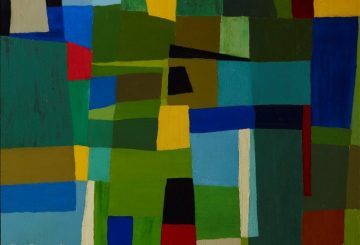Title: I Advanced Masked
Author: Justin Clemens, art critic, lecturer in psychoanalysis.
Newspaper/DOP: The Monthly, April 2006
Subject: Volte Face: Mike Parr Prints & Pre-Prints 1970-2005, Museum of Contemporary Art.
Bottom line: Parr is both an expressionist and a conceptualist, acutely aware of the theatrical nature of the construction of ‘self’ in both art and life: “Parr’s art is anti-theoretical: he forces you to become something more than a simple regardeur. Parr accomplishes this by going through, not against, theory and theatre.”
Why a psychoanalyst can be a great art critic: “What do you make of someone who can happily move between such thinkers as Reich, Marcuse and Lacan, and everywhere alludes to Wittgenstein and Freud? Parr has never apologised for nor given way on his intellectual fidelities; an anomaly in the Australian art world, where theory can be high as long as it’s thin, and where artists scrabble for newly discounted thinkers like punters at a Boxing Day sale. Parr mobilises psychoanalysis to help him bind the cerebral to the physical, the aesthetic to the political. It provides him with problems on which he can operate, and subjects on which to experiment. Reich, for example, inspired the question: “So there’s something lodged within the body, how do we find this thing?”
Hello Esteemed Critic! “In response to a review by Elwyn Lynn in The Australian, Parr once protested that his works were “far more accessible than Lynne would lead his readers to believe”. The great English art critic Peter Fuller later brayed, “Parr’s work is simply too unpleasant to describe in any detail.” Committed to an entirely different tradition – a conservative interpretation of nineteenth-century English aestheticism – Fuller at least had the decency to nominate a powerful enemy when he saw one. Recently, Parr has been denounced by other conservative critics, less decent, less intelligent, way more boring and timid than Fuller. If such critics are right about nothing else, they at least make this clear: Parr’s work forces you to take sides”
Fun Fact: “The word ‘theory’ derives from the ancient Greek theoros, meaning ‘spectator’”.
*
Title: Image Fatigue
Author: Sebastian Smee, ‘national’ art critic.
Newspaper/DOP: The Australian, April 29, 2006
Subject: Contemporary photography.
Party Like It’s 1899: “The arguments about whether photography deserves to qualify as an art form may seem redundant today, but they once were complex and gnarly and never quite conclusive. Why? Because the various possible answers to the question ‘What makes a great photograph?’ never stood in a straightforward relationship to the question ‘How much artistry is involved in taking a great photograph?’”
Actually, The Party Was Five Years Ago: “After the heyday of only a few years ago, when photography seemed everywhere and Australia’s most internationally acclaimed artists (Tracey Moffatt, Bill Henson, Patricia Piccinini and Rosemary Laing) were all working in it, museums are becoming increasingly reluctant to pin much hope on photography’s capacity to keep people enthralled. Apart from the Henson retrospective in Sydney and Melbourne in 2004-05, no great photography exhibitions have been mounted in Australia’s main public galleries in years.”
The World Is A Mean Place: “Photography today has been thrown back on itself and the question of what it must do to retain interest as art is once again freshly alive. The problem is that, thanks to the digital revolution, the frisson of excitement that used to accompany photographs (the knowledge that the image was evidence for something real, a trace of something that happened) is slowly disappearing. It’s not as if photographers haven’t been involved in fabrications and manipulations since the outset. The early days of the medium were full of trickery and theatre, cases of day being turned into night just to suit the photographer’s purposes. But today the whole context has shifted: the layers of artifice seem unending and the thread connecting photography to the real has been snapped.”
Incredible Claim: “Thanks to the digital revolution, there is virtually nothing that can’t be done to a photograph to alter its once unique relationship to reality.”

